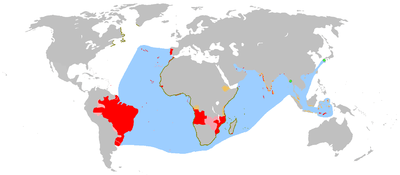Military of Macau under Portuguese rule
Macau was under Portuguese rule until 1999. Prior to the handover to the People's Republic of China, Portugal had only limited military personnel in Macau; the last major military units having been withdrawn following the Carnation Revolution of 1974. There would be no military presence until the handover in 1999 with the establishment of the People's Liberation Army Macau Garrison.
Military installations
- Fortress of St. Paul of Monte or Monte Fort 1616-1762
- Barra Fort - once had 22 cannons
- São Francisco Barracks 1864
- Fort Mong Ha 1864-1960s
Army
Historic
During much of the colonial period, the Portuguese garrison of Macau comprised a mixture of units from Portugal itself, African troops from Mozambique and locally recruited indigenous soldiers. The colonial troops, whether Chinese or African had Portuguese officers and some NCOs. In accordance with general Portuguese colonial practice they served in units designated as Caçadores (Light Infantry). Prior to 1914 a pale blue-grey zouave style uniform was worn by the Mozambique askaris with red fezs and sashes for parade. The Macau units wore indigenous pattern dress of the same colour with conical headdresses.
1936-1940
In 1936 the garrison consisted of 497 men - 22 officers, 35 NCO's and 440 soldiers, including 224 native soldiers increasing to 797 men in 1940. They were organised as follows-
- 1 European infantry company
- 1 European artillery company
- 1 heavy machine-gun company
- 2 native companies
- 1 depot section [1]
1941-45
Following the surrender of Hong Kong in December 1941 the Japanese respected Portuguese neutrality. However, although Japan did not formally occupy Macau, Japanese troops transited the territory at will.
During World War II, the Portuguese had:
- 1 Portuguese infantry company up to the start of World War II replaced by-
- 1st Mozambique Light Infantry (Mozambique Caçadores) Company
- 2nd Mozambique Light Infantry (Mozambique Caçadores) Company
- 1 Portuguese artillery company (Companhia de Artilharia)
- 1 heavy machine gun infantry company (Companhia de Metralhadoras)
- 2 native infantry companies (Companhia Indigena de Caçadores)
- 1 depot section
- military detachment in Taipa (Destacamento militar na Taipa)
- military detachment at Ilha Verde (Destacamento militar na Ilha Verde)
1946-1964
Following the war the machine gun company was changed to an armoured cavalry squadron equipped with armoured cars. Five indigenous companies (Companhia Indígena de Caçadores) were posted at Colane, Flora, Ilha Verde, Mong Ha and Portas do Cerco. An anti-tank (Companhia de Anti-Carro) was posted at Ramal dos Mouros.
Final colonial period
The last of the Mozambique Caçadores were withdrawn from Macau in 1964, after the outbreak of wars of independence in Portugal's African possessions. The Portuguese garrison in the colony effectively ceased to exist following the change of government in Portugal in 1974 and the agreed timetable for a takeover by mainland China in 1999. For the remaining quarter century of Portuguese administration order was kept in the territory by a civilian police force without military backing.
Navy
The Macau Naval Aviation Centre was created in 1927 as a seaplane base to combat submarine activity in and around Macau. It was decommissioned in 1933, but re-activated from 1937 to 1940. The naval station was later moved to the Outer port in 1940 and de-commissioned after 1942. The naval station in Macau was part of the Far East Fleet.
Portuguese naval ships stationed in Macau:
- cruiser Rainha Dona Amélia - stationed early 1900s
- cruiser Vasco da Gama - stationed early 1900s
- gunboat Pátria - constructed in Lisbon in 1903 and entering service in Macau in 1909.
- small shallow-draught gunboat Macau - built in Scotland, shipped to Hong Kong in crates, and launched in 1909. The Macau was sold to the Japanese in 1943 where it was renamed the Maiko.[2] After World War II it became the Chinese Nationalist Navy boat Wu Feng [3] and later served in the Navy of Red China until 1968.[4]
A naval air station was established in 1927 with limited equipment.
When it was discovered that neutral Macau was planning to sell aviation fuel to Japan, aircraft from the USS Enterprise bombed and strafed the hangar of the Naval Aviation Centre on 16 January 1945 to destroy the fuel. American air raids on targets in Macau were also made on 25 February and 11 June 1945. Following Portuguese government protests, in 1950 the United States paid US$20,255,952 to Portugal.[5] The Japanese presence ended in August 1945.
Air Force
From 1956 to 1974, Macau was under the 3rd Aerial Region (3ª Região Aérea) with its headquarters in Lourenço Marques.
A list of some aircraft stationed in Macau prior to 1974:
- 3 Fairey IIID - recon biplane - sent in 1927
- 4 Hawker Osprey floatplanes naval biplane light-bomber (sent before or around 1940)
- Avro 626 biplane trainer
- Grumman G-21B amphibious monoplane
Commanders in Macau
- Governor Gabriel Maurício Teixeira 1941-1945
- Chief of Staff: Major Carlos da Silva Carvalho
See also
Notes
- ↑ pp 114-115 Garrett, Richard J. The Defences of Macau: Forts, Ships and Weapons Over 450 Years Hong Kong University Press, 01/02/2010
- ↑ http://www.combinedfleet.com/maiko_t.htm
- ↑ http://www.navypedia.org/ships/portugal/pr_of_rio_macau.htm
- ↑ http://www.navypedia.org/ships/china/ch_of_wu_feng2.htm
- ↑ p.116 Garrett, Richard J. The Defences of Macau: Forts, Ships and Weapons Over 450 Years Hong Kong University Press, 01/02/2010
| |||||||||||||||||||||||||||||||||||||||||||||||||||||||||||||||||||||||||||||||||||||||||||||||||||||||||||||||||||||||||||||||||||||||||||||||||||||||||||||||||||||||||||||||||||||||||||||||||||||||||||||||||||||||||||||||||||||||||||||||||||||||||||||||||||||||||||||||||||||||||||||||||||||||||||||||||||||||||||||||||||||||||||||||||||||||||||||||||||||||
